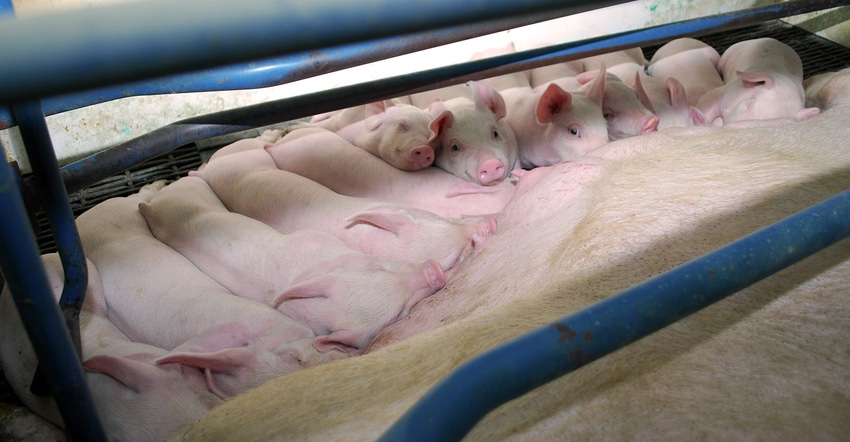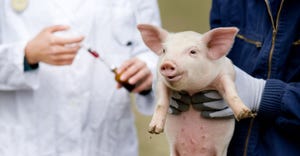Part 2: What is going on with female death loss and culling?
When the data are broken out by the younger females, Parity 0 to Parity 2, they account for 29-47% of all the females culled.

To continue our look at female death loss and culling, the second area we are going to deal with in this article is to take a look at culling. Next month, we plan to look at total removal of females from the farm, which will be both female death loss and culling.
The data set we used for this article was from our large farm benchmarking database with about 1.7 million sows from the United States, Canada and a small set of farms from Australia. Out of that data set, we selected farms that were at 22-plus pigs weaned per mated female per year and did not include start-up farms, ones that were depopulating or repopulating, or expanding or reducing female inventory. That left 493 farms with 916,973 mated females in the data set. The farms ranged in size from less than 200 to 6,000-plus mated females with average farm size of 1,890 mated females.
Chart 1, Number of farms by size, has the breakdown of the 493 farms used in the study looking at culling. There were four farms that had less than 200 sows, 68 farms in the range of 400-599 sows, 68 farms in the 2,500-2,999 sows and 13 farms that are at 6,000 sows. With this much variation it is very interesting to see how size of farm affects some of the production numbers.

When we look at female culling by size of farm, which is Chart 2, remember the chart is set up by size of farm on the X-axis and culling rate on the Y-axis with the stack graph being by parity from Parity 0 to Parity 7-plus females. Remember that Parity 0 would be mostly pregnant females that have not yet farrowed or females that recycled. The chart shows that across most farms by size that culling percent is about 40% annually with higher numbers from the 800- to 1,399-sow farms and higher for farms 3,000-plus sows with the higher culling from farms with 6,000-plus sows at 54%.

Why are these large sow farms culling more animals? It appears that they are culling more Parity 0 and Parity 1 females than the smaller farms. Is this to do more with these farms having a steady flow of gilts and after being heat checked for 30-45 days for heat or them culled and after farrowing than culling more Parity 1 sows that are not cycling or had poor performance in farrowing? What are sow farms doing for gilt development units on the farm to allow for better development and control of the growing phase for the gilts? With most farm-entering gilts at breeding time, it is very hard to figure out what percent of gilts that arrived did get bred and farrowing at least one litter. An area that needs a lot more study.
Chart 3, Culling rate by pigs weaned per mated female per year, shows a linear trend line with culling rates at less than 40% for sow farms producing 26 pigs or less and increasing as pigs weaned per mated female per year go up. The sow farms at 32-plus pigs per sow had culling rate average at 54%. Are these the larger sow farms at 6,000-plus sows? When looking at parity, most farms show 10-12% of the sows culled are older Parity 7-plus females with the 32-plus sow farms lower at 9%. This chart shows the most productive farms cull a higher percent of Parity 0 and Parity 1 females. What are these farms doing different about culling criteria?

Chart 4, Culling rate by entry to first service interval, shows the wide range of days for entry into the farm to being bred going from zero breeding at delivery to the farm or in developing 80-plus days before being bred. The data show gilts bred at arrival had culling rate at 48% dropping to 39% for being bred at Day 60 and then going back up to 51% for gilts bred 80-plus days after arriving at the farm. Is the higher culling rate for early arrival gilts due to the lack of acclimatization not allowing the gilts enough time before breeding to adapt to their new environment? However, why are 50%-plus of gilts in the farm 80 days being culled?

Like we did with female death loss, we wanted to see what percent of the younger females were being culled from Parity 0 to Parity 2. Charts 5, 6 and 7 look at this. Chart 5, Culling by farm size, breaks sow farms out from zero to 199 to 6,000-plus sow farms. The X-axis shows Parity 0 to Parity 2 percent culled (blue bar), total culling percent (red bar) and percent of Parity 0 to Parity 2 of total (black line). The chart shows culling for Parity 0 to Parity 2 lower for smaller farms at 11.1 to 13.50 with the farms 2,999 and 3,000-plus sows up at 16.6 to 25.50% for farms at 6,000-plus sows. If you look at the data by percent of Parity 0 to Parity 2 of the total culled, you see smaller farms at 199- to 2,999-sows at 25.6 to 43.2%, and again larger sows farm at 3,000-plus sows at 37.0 to 47.08% for the farms 6,000-plus in size.

Chart 6, Culling by pigs weaned per mated female per year, which is based on pigs per sows, the Parity 0 to Parity 2 percent in a range of 12.8 to 14.3% for all farms except the farms at 32-plus pigs when the number goes to 20.1%. If we look at this by percent of Parity 0 to Parity 2 of the total, the percent goes from 29.3 to 34.8 for farms at 23 to 31 pigs per mated female and for farms 22 pigs up to 36.3% and farms at 32-plus pigs at 36.7%.

Chart 7, Culling by entry to first service interval, looks at the wide range in days from when a gilt enters the record program until they are served (bred). The chart goes from zero to 80 days. If we look at Parity 0 to Parity 2 percent (blue bar), you see the range of 10.7 to 21.8% with 14.30% culled for Day 0 entry to 21.8% for Day 80. When you look at the percent of Parity 0 to Parity 2 of total, you see 30 to 32% being culled Days 0 to Day 50 and then a drop to 25.9% for Day 70 and back to a high of 42.2% for farms at 6,000-plus sows.

What did we see? That overall farms are culling in a range of 39-53% of all females with the larger farms of 6,000-plus sows and the more productive farms at 32-plus pigs at 53%. In most farms, they are culling more of the Parity 0 and Parity 1 females. When the data are broken out by the younger females, Parity 0 to Parity 2, they account for 29-47% of all the females culled. The larger farms, 6,000-plus, seeing 47% of the females culled being the younger Parity 0 to Parity 2 females. What is going on at these larger farms to lower retention of all females with culling at 54.2%? Where is your farm on gilt development? What percent of the gilts that you purchase or raise within your system see at least one litter?
Next month we are going to combine female death loss and culling as a look at total removals from the farms.
Table 1 provides the 52-week rolling averages for the 11 production numbers represented in the Swine Management Services Production Index. The numbers are separated by 90-100%, 70-90%, 50-70%, 30-50% and the 0-30% groups. We also include the 13-week, 26-week and 12-quarter averages. These numbers represent, what we feel, are the key production numbers to properly evaluate the farms' performance.

At SMS, our mission is to provide "Information solutions for the swine industry." We feel with the creation of different SMS Benchmarking databases for all production areas, we now have more detailed information to share with the swine industry. If your farm would like to be part of the SMS Benchmarking databases, or if you have suggestions on production areas to write articles about, contact Mark Rix, Ron Ketchem or Connor Sharp. We enjoy being a part of National Hog Farmer's NHF Daily team. Previous articles can be found at NationalHogFarmer.com.
Source: Ron Ketchem, Mark Rix and Connor Sharp, who are solely responsible for the information provided, and wholly own the information. Informa Business Media and all its subsidiaries are not responsible for any of the content contained in this information asset. The opinions of these writers are not necessarily those of Farm Progress/Informa.
About the Author(s)
You May Also Like




